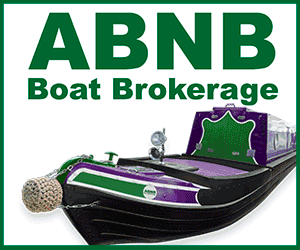Bonkers Boats
From boat/caravan hybrids to narrowboat-scale Royal Navy ships, we round up some of the most unusual craft to have graced the inland waterways
The cardboard boat

Picture credit: Brian Tulga
Grand Designs presenter Kevin McCloud proved cost shouldn’t stop aspiring boat-owners from getting afloat, debuting a DIY, ‘here’s-one-I-made-earlier’ cardboard craft on the Thames in 2016. It was constructed by Harry Dwyer and Charlie Waller of Aircraft Workshop over the course of a week, and was made entirely from recycled material that had piled up in their bins. Billed as the world’s first cardboard houseboat, the waterproofed vessel was fitted with a motor and the interior featured two bunks and a kitchen.
The caraboat

The brainchild of Tom Carr, the curious boat/caravan hybrid first hit the water in 1971. It boasted a sturdy fibreglass hull and internal chassis, with only the brakes and suspension mounted on the outside. It could be towed like a normal caravan, but came into its own when reversed into water and fitted with an outboard motor to make a four-berth self-propelled cruising craft, complete with front ‘French’ window, cooker, sink, wardrobe, toilet and two small seats in the well deck. Only 64 caraboats were ever made, with production coming to a halt after a party aboard one of the craft ended in disaster and Carr, overcome with remorse, destroyed all plans – or so the story goes.
The Piano Raft

Picture credit: Ben Cummins
Ben Cummins, skipper of the unpowered piano raft, gave himself up to 25 years to haul his floating home from Liverpool to London by hand. After five years he’d made the 127-mile journey to Leeds, where he’s since stayed put – but the mission to reach the capital via the canals remains. The raft itself was rescued from a warehouse in Liverpool and has evolved and expanded to three times its original length and four times the weight. Discarded planks, freezer doors and drawers serve as makeshift superstructure, bulkheads and storage, while the entire thing floats on ubiquitous blue plastic barrels.
The County-class destroyer

In the early 1970s, boat-builder John Pinder received a rather unusual commission: four miniature warships. The order was placed by the Royal Navy, which hoped to use scaled-down versions of their fighting craft as recruitment tools by touring them on the inland waterways. Based on narrowboat hulls, the boats were fitted with Thornycroft engines and created quite a stir around the system.
The German U-boat

Continuing the naval theme is this World War II-era German U-boat simulacrum, seen on the Leeds & Liverpool Canal in 2010. At the time, its skipper told the BBC that he built the submarine when he couldn’t find a real one to buy for his 50th birthday. The £55,000-plus floating folly came complete with conning tower, periscope control room, submarine bunks and forward torpedo tubes. It materialised out of a basic 45ft Collingwood Boats sailaway with an Isuzu engine, but was pimped with a slew of modern electronics, including external video cameras and security equipment.





